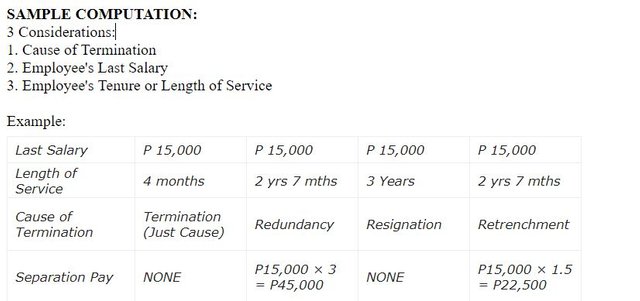How is Separation Pay Computed?
One of the despondent event in an employee-employer relationship is "separation". There are different circumstances on how it ends.
RESIGNATION - employee makes the decision to end his relationship for reasons like career advancement (greener pasture), personal reasons, family reasons, or just simply end the working career and do business or retire.
In other circumstances, the decision comes from the employer. Business transformation of the impact of automation may mean the REDUNDANCY.
Business losses, closure or cessation of operations are triggers of RETRENCHMENT.
In most cases, employees, through their own misconduct or poor performance, leaves their employer with no choice but TERMINATE them. The process must be well managed, well documented, fair and reasonable. As per Art. 282 (Termination by employer), An employer may terminate an employment for any of the following causes:
a. Serious misconduct or willful disobedience by the employee of the lawful orders of his employer or representative in connection with his work;
b. Gross and habitual neglect by the employee of his duties;
c. Fraud or willful breach by the employee of the trust reposed in him by his employer or duly authorized representative;
d. Commission of a crime or offense by the employee against the person of his employer or any immediate member of his family or his duly authorized representatives; and
e. Other causes analogous to the foregoing.
SO WHO ARE ENTITLED TO SEPARATION PAY?
The following are entitled to Separation Pay.
Employees who are affected of:
REDUNDANCY
TERMINATION DUE TO AN INSTALLATION OF LABOR-SAVING DEVICE
RETRENCHMENT TO PREVENT LOSSES
CLOSING OR CESSATION OF OPERATION OF THE ESTABLISHMENT OR UNDERTAKING
TERMINATION CAUSED BY DISEASE
HOW IS IT COMPUTED?
Art. 283 of Labor Code.
Closure of establishment and reduction of personnel. The employer may also terminate the employment of any employee due to the installation of labor-saving devices, redundancy, retrenchment to prevent losses or the closing or cessation of operation of the establishment or undertaking unless the closing is for the purpose of circumventing the provisions of this Title, by serving a written notice on the workers and the Ministry of Labor and Employment at least one (1) month before the intended date thereof. In case of termination due to the installation of labor-saving devices or redundancy, the worker affected thereby shall be entitled to a separation pay equivalent to at least his one (1) month pay or to at least one (1) month pay for every year of service, whichever is higher. In case of retrenchment to prevent losses and in cases of closures or cessation of operations of establishment or undertaking not due to serious business losses or financial reverses, the separation pay shall be equivalent to one (1) month pay or at least one-half (1/2) month pay for every year of service, whichever is higher. A fraction of at least six (6) months shall be considered one (1) whole year.
Art. 284 of Labor Code.
Disease as ground for termination. An employer may terminate the services of an employee who has been found to be suffering from any disease and whose continued employment is prohibited by law or is prejudicial to his health as well as to the health of his co-employees: Provided, That he is paid separation pay equivalent to at least one (1) month salary or to one-half (1/2) month salary for every year of service, whichever is greater, a fraction of at least six (6) months being considered as one (1) whole year.
Important to NOTE:
30-day Notice to the employee must be served.
REDUNDANCY - at least his 1 month pay or 1 month pay for every year of service, whichever is higher
RETRENCHMENT TO PREVENT LOSSES - at least his 1 month pay or 1/2 month pay for every year of service, whichever is higher
CLOSURE or CESSATION OF OPERATION - at least his 1 month pay or 1/2 month pay for every year of service, whichever is higher
TERMINATION DUE TO DISEASE - at least his 1 month pay or 1/2 month pay for every year of service, whichever is higher
NOTE: A fraction of at least 6 months is considered 1 whole year.
WHO ARE NOT ENTITLED TO SEPARATION PAY?
Resigned employees are not entitled to Separation Pay, unless there is an existing CBA/Union Agreement or Company Policy or Practice.
Employees who are Terminated due to Just Causes (Article 282 of the Labor Code) are not entitled to Separation Pay.
IS SEPARATION PAY TAXABLE?
Separation pay under the ruling of Section 32.B.6.b of the 1997 Tax Code, separation pay shall not be subject to income tax and withholding tax.
